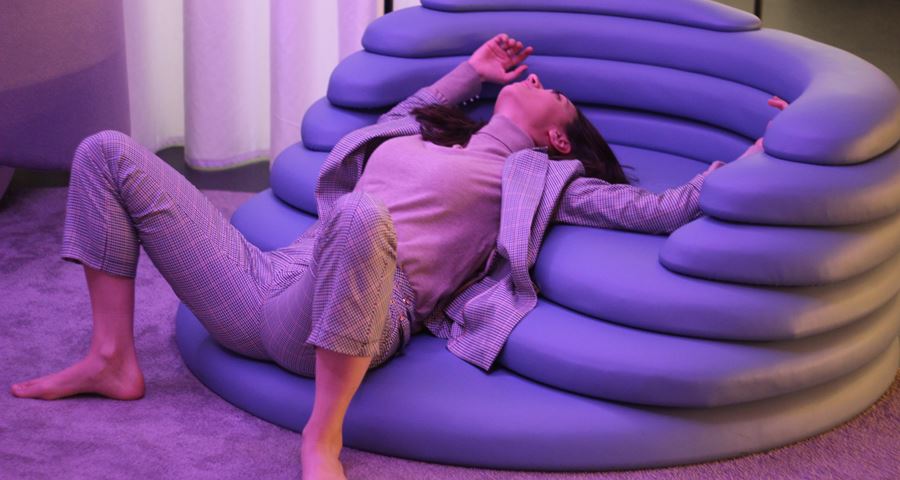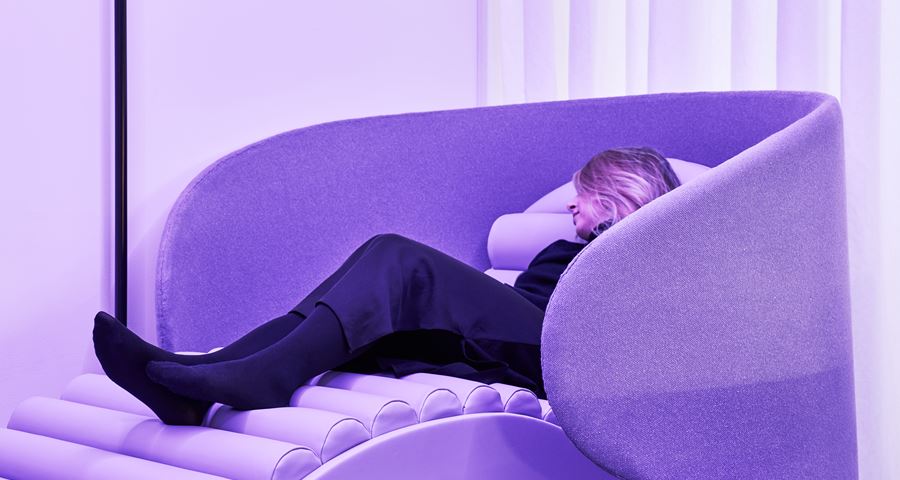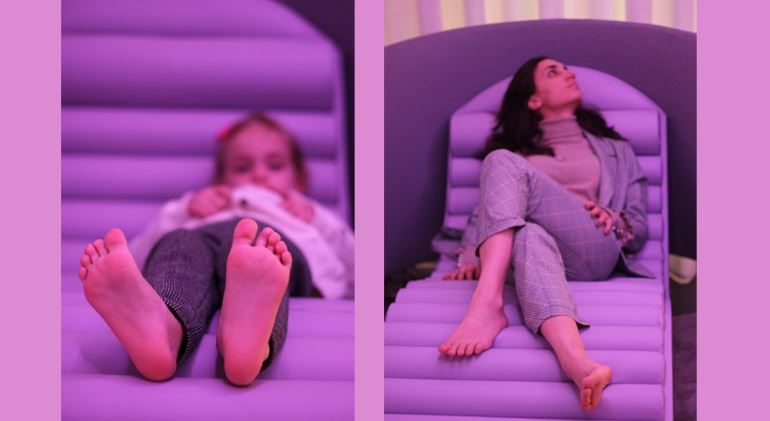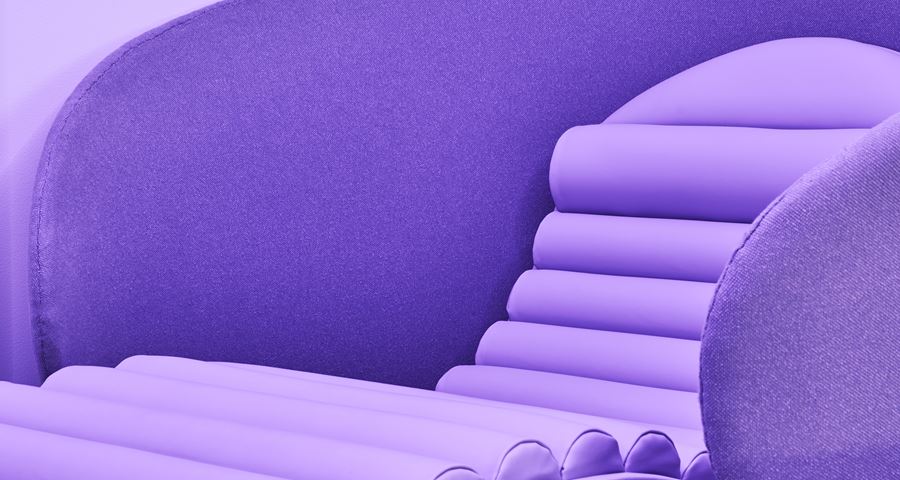Designers in Residence
Q&A - Stiliyana Minkovska
To mark International Women's Day, the Design Museum caught up with one of this year's designer in residence, Stiliyana Minkovska, the architect behind Ultima Thule.
#DesignersinResidence

Q:Tell us a little bit about your background?
My name is Stiliyana and I am a qualified architect. I wanted to become an architect since I was 14 and entered a high school for architecture, but since my score wasn’t high enough to meet the programme’s standards, I was accepted to study Hydro Engineering. During that time, my hunger for architecture grew even bigger. Then I came to England to study Architecture at Oxford Brookes, RCA and the Bartlett. Since I became an architect in 2018, my interest in conventional (buildings) architecture regressed. I am now more interested in the temporal side of design such as experiential, set and exhibition design, and most recently in product and furniture design…I guess they all are metamorphosis of architecture.
Q: How did the birth of your daughter, Stelena, in 2016 – inspire your project, Ultima Thule?
A: Stelena was born when I was halfway through my final year of MA Architecture programme at the RCA. She was supposed to be born on 20 December 2015, but she arrived on 3 January 2016…we always joke she came a year later, which in a way is true. These two weeks were exhausting, mostly from the social pressure of people constantly asking me what was going on or whether everything was fine with the baby. As if I was holding her back in. Some people were even telling me that I should arrange a cesarean as this lateness could affect her health. It was horrific and it was also Christmas and New Years’ time, all festive and jolly around. I self-admitted myself to St Thomas’ on 31 December. At the hospital, I was put in a maternity ward where women with complications normally are awaiting their births. My body changed four locations during my stay at the hospital. Initially, the maternity ward during the attempts of inducement. Then the birth centre where my waters were broken and labour phase commenced, which I found the most painful part. The labour ward was where I was transferred for the actual expulsion – a highly medical spatial condition where complicated births are being carried out and where Stelena was born. Eventually, the postpartum ward with the most gorgeous view of Big Ben. It was surreal and wonderful, although I was pushed there on a wheelchair, which was an anticlimactic sensation…
My research at the RCA looked into the maternal-female body as a place, as an envelope and as a container for the child. During the actual birth (after the labour phase), I filmed the process as part of the Work-In-Progress Show at the RCA. I questioned the labour of giving birth by creating a multi-screen installation, filmed from different angles. One camera was on the midwife’s head. I questioned birth as a conducted event by the medical personnel as I felt my body was going against its instincts by being told what to do and how to be in control. Perhaps, it was for the benefit of both myself and my daughter’s well-being but at the time it felt under huge surveillance and supervision.
Ultima Thule was inspired as a continuation of my thesis project at the RCA. There I designed a planetarium-like birth centre where women undergo all processes involving childbirth in the same spatial condition, designed by them based on their needs and preferences, contrasting my experience of changing scenery throughout Stelena’s birth. Space, on the other hand, felt like a comfort blanket. It was the farthest I could imagine, and it felt good.

Q: What did you find the hardest? Pregnancy, childbirth? And, how did you prepare for your delivery?
A: Pregnancy was a smooth and enjoyable experience. I loved reading feminist literature by Luce Irigaray, Julia Kristeva and Simone de Beauvoir regarding female re-productivity and maternal transformation. I remember my parents telling me off for not reading literature, concerning preparing for childbirth. My mind was focused on my degree and the design processes involved around pregnancy and childbirth. I didn’t have time to go to any classes, I only attended the compulsory antenatal ones at the hospital. I wish I had a doula or a person I could connect to as my mother was in Bulgaria, but I never felt the need of extra help during the pregnancy period.
I had my final review at the RCA on a Friday and my due date was on Sunday. I believed I’d give birth on my due date, considering the kind of easy pregnancy I had. Well, my daughter had other plans. I was preparing for two weeks, eating all the pineapple I could possibly take (my mouth was so sour), curry, long walks, intimacy and so on – nothing helped! I remember inventing my own stories just so I can go and be checked such as ‘the baby is not moving normally today’. I felt helpless and anxiety was taking over.
Once all unsuccessful inducement methods were over, both prior and post my admission to hospital, on 3 January in the morning around 10.00 am the loveliest woman came to me to say, ‘Let’s go, you will be giving birth today’. I was surprised as my body had no signs of such occurrences.
I had my waters broken and hell began. The pain is so foreign and uncontrollable, it felt as a possession. It happens to you; you have no control over it. You cannot prepare for it I think, unless you know what to expect. For a first-time childbirth, with no experience, no doula involvement, no pregnancy yoga, no breathing techniques, I found myself alienated. My mother and partner were around during the labour, which made me feel further pain as I was worried about them feeling stranded by my movements, roars and behaviour in general.
The contractions during labour feel like an extraneous possession. The body has no control over them, they are involuntary and powerful, which creates a sense of helplessness. The contractional sensations bend, flex, manoeuvre and stretch the maternal envelope. Women experience fear because of the environment they are required to reproduce within. The design elements which they interact during the most painful and most alien phase of their lives is not appropriate in order to meet the requirements for flexibility, adjustment, modularity and control over functions. The past and current design offerings during the antenatal, labour phase have special contribution to the alienation of women from the birth-giving process. The elements of offerings during the expulsion phase are either non-existent, or regressive and dehumanised. The moment between the baby’s head dresses down the pelvic floor until it is born is the most cataclysmic and requires strong design attention. Women should feel that the birth environment works around their needs and comfort.
This is how the Labour Silla was born – to support this mad alteration of the maternal bodily agency and accommodate its instincts.
Q: You have designed an inclusive space which encourages visitors to relate to the installation regardless of their procreative experiences. How do your three chairs in the space do this?
A: The Labour Silla is for women who do go into labour. It is designed as an object in process so women can find comfort and ease during the most painful and alien phase during childbirth. Of course, not all women go into labour, therefore the Labour Silla could be reimagined for people to gather together, speak to each other, women could be massaged and looked after one way or another.
The Parturition Stool was designed as a tandem. I enjoyed having my partner right next to me, rather than being in front of my spread legs, observing…this would have made me very anxious and uncomfortable. I thought it was beautiful to hear encouraging words as well as be given water and be stroked. I think in my case, Stelena’s birth was a result of immense amount of love and passion of two people for each other. I thought about this stool as a partnership of a shared journey. Whether it is your partner, parent, friend or the midwife herself, it has been designed so the birthing person feels the support, literally somebody to lean on.
Of course, not all women decide to have assisting partners whether by choice or by virtue. Some women prefer to be alone, therefore the lower seat has implemented the design for handlebars, which women could push or pull onto. In this case, the stool could be used by a single person.
The Solace Chaise is the postpartum recovery element. This piece is where all women are urged to be part of, to feel celebrated for their reproductive economy and the control over it. The Solace is designed so women have a privacy when breastfeeding, bonding with their baby, recovering from a traumatic birth experience, abortion or miscarriage. Its padded design, together with the privacy hood are fabricated ergonomically to provide the comfort, enclosure and time alone, which is most needed.

Q: How does your alternative birthing suite cater for women who value privacy over distractions? How can such an environment assist with labour?
A: Most definitely! Birth is a sacral transformation during which the maternal body re-envelops within itself from a container for the foetus into a place for the new-born child, nurturing and embracing. The parturition environment has to invigorate the mother to feel in control over the evolution of processes, rather than being controlled as often occurs within the medical institution.
The birthing setting within the institution of the hospital is a space which often lacks soft and female-centred qualities. Although, hospitals have developed techniques, which hide away the masculine presence of technology and equipment, necessary in case of emergency, the spatial quality itself does not carry the warm womb-like, soft, human-centred design aspects. The space should be calm, with a carefully chosen colour and lighting palette, which placates the maternal neocortex. A spatial condition limiting the amount of distraction and foreign stimulation, which leads to more melatonin discharge - ‘the darkness hormone’. It is the hormone which works in collaboration with oxytocin in order to assist labour and delivery and reduce the neocortical activity. The limited neocortical activity is a key to the physiological pain reduction during labour.
Privacy is another basic need, requiring interpretation during labour and birth. Women tend to be more focused on observing themselves when they are being examined and looked at. Reduction of direct lighting, warmer spatiality through colour and materiality as well as the reduction of monitoring could benefit the birthing women and direct their attention towards meeting the new life emerging from their re-enveloping bodies. It is also crucial for the mother not to be cold, because the warmth induces the natural oxytocin release.
These are some of the reasons why Ultima Thule was designed in such manner. As a birthing sanctuary, where the mother and the baby remain together and where they are not treated as separate entities, although they are distinctive living organisms. Their continuum and closeness remain for as long as needed. The space does not reminiscent the hospital ward, where mothers are rushed in and out. It does not carry the medical qualities, linked to diseases and disorders, inducing tension and anxiety. This spatial quality is carefully selected to reference the womb with its atmospheric and cosmic merit.
Q: Your multi-sensory suite seeks to bring mother and baby closer together, how did you manage to capture such an atmosphere (materiality, lighting and sound)?
A: I knew from the beginning that I would like to have an immersive installation, where women could feel celebrated, regardless of their choices, stories, burdens or life events which might have changed them forever.
I worked closely with a very talented sound designer Laura Selby, who under my art direction composed a beautiful 10-minute-long soundtrack of what the sound within the womb would be like for the baby. I loved the collaboration as it was my first time getting involved with sound design.
For the atmospheric light, I worked with LED Flex, who donated their incredible product. I designed a specific colour palette which they transferred into a beautiful lighting track. The carpenter who fabricated the frames for the chairs also made the lighting ring, which gives the cosmic, womb-like glow.
The floor is covered by a rug, kindly donated by Desso. Softness was a huge part of the project and the rug gives this homely feeling, which people can easily relate to. Everyone loves being home, especially during the alien process of childbirth.
The upholstery material used for the chairs is a leather-like vinyl which is hard-wearing and commercially durable product used throughout the healthcare sector. Camira developed this fabric which contrasts the word ‘vinyl’ as it feels soft, kind to the skin and of course easily maintained. It does not contain any phthalate plasticisers or heavy metals which makes it stretchy and pliable, hence Oxford Upholstery did a magic by covering the chairs in the beautifully tailored fabrics.
The Solace Chaise has a different materiality for the hood, which is a blend between silk, wool and flax.
It is a marriage of different elements…

Q: What’s the most surprising or bizarre discovery from doing your research on childbirth?
A: Perhaps it is not a discovery, but the fact that the elements of offerings surrounding childbirth are both designed by men and are not progressive. It is bizarre to think that today women could choose from a broad palette of alternatives such as hypnobirthing, water birth, assisting doula, specific room and condition but the actual support in terms of product design has not advanced since the 1960s.
It was the male practitioners who founded the lithotomy (lying down) position for childbirth. Julien Clement from France and John Leake from England were the very founders of the horizontal birthing posture as oppose to the obstetrical chair with upright position, which the midwives still use outside the Western society and which is also being revived today within the healthcare practice.
During labour and birth the maternal body is placed into a supine position, which is the most common posture during surgical procedures - another sign that birth within the medical institution is considered as a clinical event. This position turns the natural desire of the woman to move, transform and flex into a passive mannequin, which is bound to a bed, instead of squatting, rotating and finding the most consoling postures in order to ease the fear and pain. The labour ward becomes the set for a cinematic operational drama, where the birthing mother is the experiment of a heroic male obstetrician.
With the acceptance of the lithotomy posture as the norm, various anaesthetic measures were created in order to prevent the mother from the physical pain. ‘Twilight Sleep’ is one of the most common methods used during the 20th century, which was a mixture of morphine and scopolamine. It was commonly used until the toxic side effect for the newborn was proven. The patriarchal invention in the form of an anaesthetic which could put the mother to sleep while she is being birthed and while her uterus remains contracting was a ‘great’ chloroform experiment. The woman could continue to serve her biosocial purpose as a procreative epitome without being problematic for the adversities of capitalism.
Women under anaesthesia are the tamed symbology of the masculinised birth setting. The numbness, the semi-helplessness and the inactive participation during labour and birth is all a grotesque cover for the parturient woman’s choice of control over her own body. Men made labour and birth a drugged, feelingless, supine arbitration with stirrups, hooked up with monitors and intravenous tubes in order for the maternal body to be at their disposal, to limit the options over an elective motherhood. Women become pain-free, sexually liberated beings, who could only serve the main purpose of an active procreative ‘federal reserve cave’.
Grantly Dick-Read was a British obstetrician and a pioneer towards natural childbirth. He discovered that pain increased due to fear and tension. He began to train women to relax, to remain calm and in control of their breath as well as develop a muscular strength through exercises. His introduction to self-control and obstetric assistance instead of a surgeon interference was ground-breaking.
Q: What has been the general reaction from mothers and women? What has been your most memorable piece of feedback or response?
A: It has been only a month so far and it is hard to conclude. I love when I hear from midwives, doulas or pregnant women. It is also lovely going to the space and watching people’s reactions and responses without them knowing I am the designer. The feedback so far has been very positive, which is wonderful news, but I do appreciate honesty and criticism so am happy to accept these too. It is all about the learning curve and how we can improve our built environment in the best possible way to suit our needs.
Somebody mentioned it looked like ‘an airport lounge from a Kubrick movie’ – I take that as a compliment!
Q: Did you experience any obstacles whilst working on this project?
A: There are always challenges, especially for people like me who are dreamers and believe that everything is possible. You soon land back on the ground and are stood up in front of the so-called reality.
Working with an area which is so delicate, personal and could easily trigger counter-effect, there are obstacles pretty much at every step of the journey. Childbirth is very individual, and every pregnancy differentiates. It is hard to generalise an experience of such kind. You have to be extremely careful how you communicate a project like this to avoid offending people, who might potentially feel left out – it would have been hugely disappointing! Design should be inclusive, and these series of offerings have tried to be as all-encompassing as possible.
I loved every step of the journey and I believe that the platform that the Design Museum offered me, has helped my design practice progress immensely. I think the challenges along the process were easily mitigated as I had a great team standing by me, who made sure it was all fine at the end. I am ever so grateful to the curatorial team for their efforts and hard work on this project!

Q: You have designed a space which empowers the maternal body and celebrates women’s freedom of choice on procreativity – considering today’s socio-political climate, why is this project so urgent?
A: This project is urgent not only within the 2020 socio-political context and for the emancipation of the woman as a free organisation, but as a celebration of the matriarchal empowerment, by creating a maternity haven, a place where birth is guided rather than controlled. Ultima Thule is designed to evoke a sense of a new spatiality, where the issue of pain is mitigated through the commemoration and the power of the maternal-female body, remaining fully committed to the birth rite.
A place with special focus on mother-and-baby-centred design and user experience through a series of offerings and design interactions. This project introduces a new meaning to the experience of childbirth. It is a cosmic recreation, which allows for emotive feelings. It is important for the viewer to understand the recollection and the re-imagining of the birthing mother. Mothers should feel support within the socio-economic and political climate by being able to freely design their future development as mothers, as women, as lovers and as professionals. This space through its design features allows the viewer to be able to relate to the installation piece regardless of their procreative experiences or maternal feelings.
Women do not need to have had nurtured a child in order to have maternal intelligence - it is naturally given to women by their mothers. They are embedded within their instincts as women.
We live in a world where one in five births is considered as ‘high risk’. The mother-to-be is seen somehow defective, requiring extra technological treatments, special medical monitoring and clinical prudence. Women carry their life stories and experiences with them to the birthing place. They might be diabetic, or over 35, or overweight women, or women who have had previous cesarean births, or they could be drug users. Their stories and conditions apply a social etiquette which regards them as disarmed institutional casualties. Thus, these three artefacts within their cosmos-inspired scene are specifically created for all of the autonomous individuals called women, from all races, ages and classes, and towards their liberation and somatic ascendancy.
Q: It’s International Women’s Day (8 March); do you have a message for young women considering a career in design?
A: You are needed so please join the ‘gentlemen’s club’. It is crucial women design for women in a world which is robbed of gender differences, taking the average white male as a default scenario. From the simplest, everyday product design of a smartphone which appears to be too large for the female hands or pockets to the spatial properties of our healthcare institutions and its interventional instruments such as the obstetric forceps – they all have been designed by taking the male universality as a reference. Therefore, 'we need some more girls in here, there’s too many men’.
Design is the most multicultural form of communication and women are the ones who could really make the positive difference by designing towards our well-being, comfort, peace and joy.

Q: Finally, it’s International Day of Happiness this month, which design makes you happy?
A: One that I could think of right away is Ilex Studio’s Acorn Vase, which I bought last week from the Design Museum’s shop. I think it’s magical. It is a vase which could grow mighty oak trees from tiny acorns. It is beautifully crafted, and its transparency reveals a world which we never see exposed – the roots of the tree. I feel very much related to it. It is like a transparent womb-like cocoon for flora.
Related exhibition